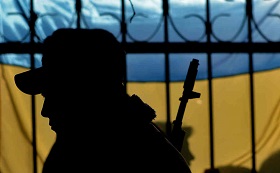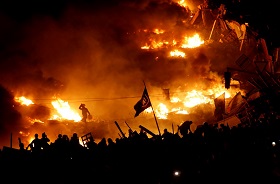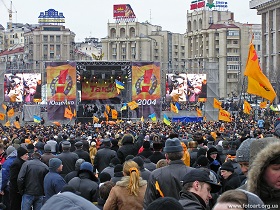Russia Between Two Maidans
Kiev, Independence Square, June 1, 2014
In
Login if you are already registered
(no votes) |
(0 votes) |
Ph.D. in History, Academic Director of the Russian International Affairs Council, RIAC Member
The end of November 2014 marks two milestones of the kind: a year since the start of the Euromaidan protests in Kiev and ten years since the first Maidan, in 2004, which triggered the Orange Revolution. Today, there is an overall reluctance to remember the first Maidan because, for many people in and outside Ukraine, it is associated with frustrated hopes and bitter disappointment. Yet, if one wants to understand the current state of affairs and the options open to Russian policy vis-à-vis Ukraine, the two events should be looked at together. The lessons of both Maidans are equally important, although they highlight different and, in some ways, opposite trends in the development of the Ukrainian state and society.
The end of November 2014 marks two milestones of the kind: a year since the start of the Euromaidan protests in Kiev and ten years since the first Maidan, in 2004, which triggered the Orange Revolution. Naturally, the first of these dates attracted much more attention, not only because human memory is short but because, against the background of the dramatic events during the past year, the Orange Revolution of ten years ago seems to be in the distant past. Today, there is an overall reluctance to remember the first Maidan because, for many people in and outside Ukraine, it is associated with frustrated hopes and bitter disappointment.
Yet, if one wants to understand the current state of affairs and the options open to Russian policy vis-à-vis Ukraine, the two events should be looked at together. The lessons of both Maidans are equally important, although they highlight different and, in some ways, opposite trends in the development of the Ukrainian state and society.
Social statics versus political dynamics?
The year since Maidan-2 highlights the headlong rush of the political process in the context of the national crisis, the rapid change of public sentiment as the military conflict escalates, and the speed at which yesterday’s leaders recede into the background, to be replaced by new, previously unknown figures. Comments on the Miadan-2 anniversary bristle with such phrases as “the birth of the Ukrainian civil nation”, “the emergence of a new Ukrainian identity”, “historic choice of the development vector”, etc.
While the past year attests to the dynamics of Ukrainian society, the decade since Maidan-1 shows its static side.
That would be the furthest thing from my thoughts to challenge these formulae, let alone be ironic about them. We are, indeed, looking at events of a historic scale for Ukraine – and not only for Ukraine. Even so, it is worth recalling that similar terminology was used ten years ago, at the peak of Maidan-1. “The Ukrainian civil nation” was already being born, “a new identity” seemed to have been formed and the “historic choice” in favour of Europe was being made.
While the past year attests to the dynamics of Ukrainian society, the decade since Maidan-1 shows its static side. This decade is not only a chronicle of “betrayal” by the Maidan leaders, as their political opponents and critics claim. It also demonstrates the inertia of social processes, the key role of economic factors, the stability of the established political culture and traditions, the volatility of social moods and many other factors that dampen the revolutionary enthusiasm of firebrand politicians.
Following the current Russian polemic around the outcome of Maidan-2, one sometimes gets the impression that Moscow, like Kiev, tends to forget about Maidan-1.
The post-Soviet history of Ukraine does not, of course, go in circles and the trajectory of events since Maidan-2 will not replicate that following Maidan-1. Yet nor is Ukraine’s history a linear process. Like any other complex, pluralistic and internally contradictory modern society, Ukraine is developing in a spiral, finding intuitively or consciously difficult and by no means always ideal compromises between the old and the new, between political will and socio-economic reality, the dialectic of change and the metaphysics of stability. Ukraine became an independent state quite recently, its political institutions are fragile and fickle and the political pendulum swings violently. But Ukrainian society has been taking shape for centuries and the country’s basic socio-economic stability moderates these swings again and again.
Ukraine is not unique in that sense. In many post-Soviet republics, turning points in their recent history have revealed a wide gap between ambitious political projects, on the one hand, and the basic socio-economic conditions, on the other. At the end of the day, political projects have had to be tailored to the social and economic realities, and not the other way around.
Pushing what is falling?
Why is it important for Russia? Following the current Russian polemic around the outcome of Maidan-2, one sometimes gets the impression that Moscow, like Kiev, tends to forget about Maidan-1. Only, while in Kiev the historical amnesia leads to unjustified optimism about the chances of breaking with the “confounded past” once and for all and heading for a “beckoning” Euro-Atlantic future, in Moscow it prompts unwarranted apocalyptic scenarios of the development of relations with Ukraine.
Assuming that, should the current regime in Kiev stay in power, Russia would “lose Ukraine forever”, that the Russian language would soon be banned, that NATO garrisons would be deployed on the boundaries of the Belgorod and Voronezh regions and National Guard units would soon march on Crimea, then it would be very difficult for Russia to do business with such a regime. In any case, there is no point in helping Kiev deal with its problems.
Because the problems are many, the chances are that the present Ukrainian regime will soon collapse and this will result not only in one leader replacing another (like Viktor Yanukovich replaced Viktor Yushchenko several years after Maidan-1), but in a virtual collapse of the Ukrainian state. The spiral of the development of Ukrainian statehood would turn into a tailspin.
Then Russia, following the logic of an imminent Ukrainian apocalypse, should act according to Friedrich Nietzsche’s principle of “pushing what is falling”, i.e., let the crisis come to its natural and probably dramatic conclusion. Only then, after an inevitable Maidan-3, help the “healthy forces” in Ukrainian society to build a new state on the ruins of the bankrupt Poroshenko-Yatsenyuk Euro-Atlantic project.
Then Russia, following the logic of an imminent Ukrainian apocalypse, should act according to Friedrich Nietzsche’s principle of “pushing what is falling”.
Following this line of reasoning, there are a variety of ways to push over that which is already falling. To do so, it is by no means necessary to be drawn into a military showdown with Kiev (although this option, unfortunately, is present in our political discourse). It is enough to take a tough stand on the current energy, trade, customs, financial and other economic issues in the bilateral relations, to render massive support to the more radical political forces in the DPR and LPR, to toughen the conditions for Ukrainian labour immigrants in Russia and then sit back and watch the final act of the Ukrainian drama, delivering oneself of “we-told-you-so” comments. “We have warned you all along that it would come to this. Why did you have to get rid of Yanukovich?”
Some might consider such a Russian strategy logical and natural. Many might think it fair, considering the intransigence of the current Ukrainian leadership over many issues of importance to both countries. Yet, even leaving aside the moral and ethical aspects of this approach and concentrating on the risks this scenario would entail for Russia, the following factors should be borne in mind.
One should not underestimate Kiev’s ability to mobilise Ukrainian society on an anti-Russian platform.
First, one should not underestimate Kiev’s ability to mobilise Ukrainian society on an anti-Russian platform. If the Russians are ready to rally around their president in the face of pressure from the USA and its allies, why do we think that Ukrainians are incapable of doing the same in the face of pressure from Russia? Over the past year, we have heard many times that Ukraine was on the brink of collapse, of becoming “a failed state”, but this is no more than wishful thinking.
Second, increased pressure on Ukraine forecloses on the last possibility of restoring partnership relations between Russia and the West, notably the European Union, in the foreseeable future. Predictably, under this scenario, there is no chance of the sanctions being eased; on the contrary, they would most likely be toughened. On the other hand, one cannot rule out that the West might be able to marshal the necessary financial resources to keep the Kiev regime afloat, even in the face of Russian economic pressure. This scenario looks unlikely today, but then, only six months ago, many did not believe that the USA and the European Union would be able to agree on sectoral sanctions against Russia.
Increased pressure on Ukraine forecloses on the last possibility of restoring partnership relations between Russia and the West, notably the European Union, in the foreseeable future.
Third, the collapse of the Ukrainian state is fraught with many unpredictable consequences for Russia itself. The spectrum of negative consequences is very wide, from instability and political extremism spilling over the border into Russia, to the crippling financial cost of creating a new Ukrainian state. Those who are inviting the Russian leadership to play this game can hardly come up with a credible action plan that would neutralise or minimise the threats for Russia arising from disintegration of the social, political, economic and military space of a neighbouring state.
An alternative to the tough line?
Is there a different Russian strategy that promises better results with fewer risks? Drawing on the experience not only of Maidan-2, but also of Maidan-1, one can safely say that there is such an option. Both the near-term and probable medium-term and long-term consequences of the current crisis should be taken into account. The history of Russian-Ukrainian relations will not end in a year or in ten years’ time. The pendulum of Ukrainian public sentiment and political preferences will not be stuck forever at a single point; the exhilaration of the revolution will inevitably give way to the harsh realities of economic and social reform. Like ten years ago, many radical political statements coming out of Kiev today will not be translated into political practice and will remain mere monuments to revolutionary rhetoric.
Russia will never be able to “get Ukraine back”, but then, Ukraine did not belong to Russia under Viktor Yanukovich either. Even so, it is still possible to restore many important positions in that country, to minimise the damage caused to the relations between the two fraternal peoples (no quotation marks there) on the condition that Ukraine survives as a single, viable and stable state and Russia is not perceived by the Ukrainians as the main, bitter enemy of their statehood.
The second option is conditional on resumption of Russian-Ukrainian dialogue at various levels and venues. Now that the habitual links have been almost totally severed and there are few reliable channels of communication between Moscow and Kiev, any contacts become important: between experts, civil society leaders, professional communities, cultural figures, regions and municipalities. Even if quick results are not achieved, the very fact of dialogue is very valuable today.
The collapse of the Ukrainian state is fraught with many unpredictable consequences for Russia itself.
By the same token, the anti-Ukrainian rhetoric in the Russian media and hostile rhetoric against the Ukrainian leadership must be toned down. Whatever one might think about the Kiev authorities’ actions, one cannot deny the obvious fact that this is legitimate power formed as a result of democratic elections and enjoying the support of a significant part of Ukrainian society. By sticking incongruous labels like “Banderovites”, “Fascists”, “war criminals”, etc. on the members of Ukrainian leadership, we erect more barriers to constructive collaboration.
The second scenario also presupposes a start to broad cooperation between Russia and the European Union in order to prevent financial and socio-economic collapse of the Ukrainian state. The signing of the trilateral gas agreement in late October is – an admittedly limited – model for such cooperation. Another example is the decision of Kiev and Brussels to postpone bringing the economic provisions of the Association Agreement between Ukraine and the European Union into effect until the end of 2015. These models could form the basis for more ambitious tripartite projects, as mutual trust and understanding of common interests are restored step-by-step.
The anti-Ukrainian rhetoric in the Russian media and hostile rhetoric against the Ukrainian leadership must be toned down.
If the deepening of the social and economic crisis is prevented and the real prospect of Ukraine’s financial default is averted, it would be easier to achieve mutual understanding on other issues, including decentralisation of government, the status of the Donbass territories that Kiev does not control, guarantees for the Russian language and the relations between Ukraine and NATO. Of course, all these issues are within the exclusive competence of the Ukrainian state, but three-way collaboration would give Moscow a hope that Kiev might take its interests into account more than it does today.
Indeed, the positions of European partners on many of the above issues could become more balanced and objective. The current discussion in Europe on how else Russia might be punished would be gradually replaced with a more practical discussion of how, together with Moscow, to help Ukraine overcome the current crisis. Such work would be incompatible with a policy of sanctions and would accelerate their lifting or at least easing.
Join Greater Europe together with Ukraine?

Sergei Markedonov, Alexander Gushchin:
Russia and Ukraine: A Corridor of Opportunities
Obviously, the second scenario would require Russia to display much more diplomatic prowess, political flexibility and readiness to engage in dialogue with not overly friendly and reliable counterparts in Kiev (and in Brussels, for that matter) than the first scenario. There are potential risks here as well. The Ukrainian leadership might try again to resolve the Donbass problem by force. The gas deal might turn out to be just a tactical move by the European Union to ensure winter transit in 2014–2015 and bide time in the protracted energy war with Moscow. Meanwhile, broad Russian-European cooperation in stabilising the socio-economic situation in Ukraine could be greatly impeded by inertia of the sanctions regime.
The list of risks can be expanded and success is anything but guaranteed. Yet, unless strategy is sacrificed to tactics, thinking not weeks or months but years and decades ahead, the second scenario is clearly preferable to the first. And not only for Moscow, but also for Kiev and Brussels.
History and geography have ordained that, today and in the foreseeable future, no project for overcoming the crisis in Ukraine can be implemented without Russia, let alone against active Russian opposition. On the other hand, history and geography remind us that a long-term Russian modernisation strategy cannot succeed without close cooperation with the European Union countries. Finally, for the European Union, Ukraine and Russia are a natural geographical extension; our two countries are a resource that can bolster the positions of the EU vis-à-vis other global power centres.
History and geography have ordained that, today and in the foreseeable future, no project for overcoming the crisis in Ukraine can be implemented without Russia, let alone against active Russian opposition.
This objective reality does not depend on what various politicians in Kiev or Moscow might think and it will inevitably push all the parties to the conflict towards closer interaction within the Russia – Ukraine – European Union triangle. In the longer perspective, we are moving toward a Greater Europe, a common economic space from Lisbon to Vladivostok, and the current Ukrainian crisis has merely slowed down this historical process but cannot stop it. Let us note parenthetically that creation of a common space consisting of both Ukraine and Russia appears to be the most realistic option for moving forward on the “Crimean question”, which is extremely sensitive for all the parties to the conflict.
That is why the Ukrainian crisis is, at the end of the day, “a family affair” between the European Union and Russia and only, to some extent, a headache for the United States. For the US, it is more a matter of geopolitics than of vital national interests. To a degree, the White House might stand to gain from the conflict because it helps it to fulfil some of its major foreign policy tasks, from revival of NATO to forcing its European allies to increase their military spending in order to redistribute European and even global energy markets in its own favour.
As the Ukrainian crisis gradually moves from the military-political to the socio-economic dimension, the role of the United States in its settlement will diminish and that of the European Union will increase.
By contrast, for the EU, the deepening of political and social instability in the centre of the European continent poses a range of serious problems that could jeopardise the future of the entire “European project.” As the Ukrainian crisis gradually moves from the military-political to the socio-economic dimension, the role of the United States in its settlement will diminish and that of the European Union will increase. This dynamic basically meets Russia’s interests: today, it would be easier to come to terms with Brussels than to reach a breakthrough in the relations with Washington.
In the short and medium term, Russia and the West will continue to vie with each other for influence on Ukraine, and one has to be ready for that. Incidentally, one of the lessons of the two Maidans for Russia should be a thorough review of the instruments it has used to consolidate its positions in Ukraine. How effectively have we used “soft power” over the past ten years? Have we been staking on the right groups within the political elite? Have we found the right approach to work with Ukrainian youth? Have we managed to harness the potential of the Ukrainian diaspora in Russia? Have we always been proactive or have we merely been reacting to the changing situation? And, in general, has Russia had a well-thought-out strategy of relations with Ukraine over the past two decades? All these questions call for dispassionate and objective analysis because, without such a “post mortem”, Russia will continue to make the same mistakes over and over again.
One would hope that the lessons of both Kiev Maidans will not be lost on Moscow and that Russian-Ukrainian relations will follow an upward spiral and not a vicious circle, let alone slip into a suicidal tailspin.
(no votes) |
(0 votes) |






